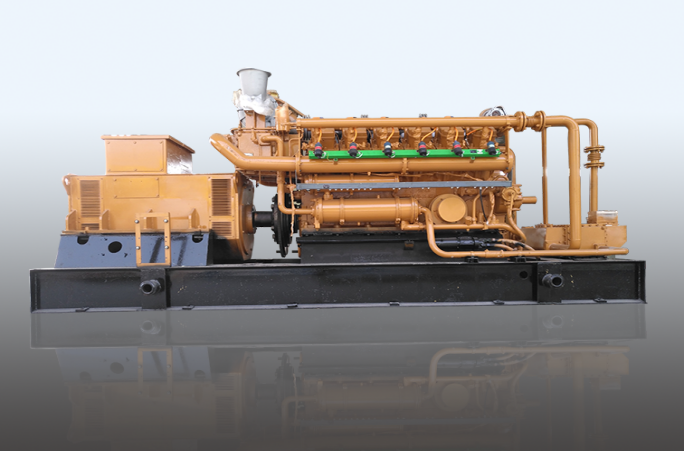—— 燃料發電設備及機組相關配套設備及配件 ——
 全國服務熱線:
全國服務熱線:

 全國服務熱線:
全國服務熱線:
 濟南濟柴環能燃氣發電設備有限公司
濟南濟柴環能燃氣發電設備有限公司
聯系電話:羅總18653152416
服務熱線:0531-62325028
聯系地址:中國(山東)自由貿易試驗區濟南片區孫村街道經十東路33688號章錦綜合保稅區聯東U谷科創中心5號樓101
合金行業尾氣發電機作為針對合金生產過程中產生的尾氣進行能源回收的設備,其設計與運行需適配行業尾氣的特殊性質,在燃料適應性、抗腐蝕能力及能源轉化方式上展現出鮮明的獨特性。
The tail gas generator in the alloy industry, as a device for energy recovery from the tail gas generated during the alloy production process, needs to be designed and operated to adapt to the special properties of the industry's tail gas, demonstrating distinct uniqueness in fuel adaptability, corrosion resistance, and energy conversion methods.
燃料適應性的精準匹配是核心特點。合金行業尾氣成分復雜,通常含有一氧化碳、氫氣、甲烷等可燃氣體,同時混雜二氧化碳、氮氣及微量硫化物(如硫化氫)、粉塵等雜質,且不同合金(如鋁合金、鐵合金、鈦合金)生產過程中產生的尾氣成分差異顯著 —— 例如鐵合金冶煉尾氣中一氧化碳含量可達 30%-60%,而鋁合金熔鑄尾氣中氫氣占比更高。尾氣發電機需具備寬范圍的燃料適配能力,通過定制化的燃燒系統(如可調式噴嘴、分層燃燒技術),實現對不同比例可燃氣體的充分燃燒,即使尾氣中可燃成分濃度波動(如從 20% 升至 50%),仍能保持穩定的發電效率。針對尾氣中含有的微量雜質,發電機需配備專用凈化裝置(如高效過濾器、脫硫塔),在氣體進入發動機前去除粉塵和硫化物,避免雜質對發動機內部部件(如火花塞、氣缸)造成磨損或腐蝕,確保設備長期運行。
The precise matching of fuel adaptability is the core feature. The exhaust gas composition in the alloy industry is complex, usually containing combustible gases such as carbon monoxide, hydrogen, and methane, as well as impurities such as carbon dioxide, nitrogen, trace sulfides (such as hydrogen sulfide), and dust. The exhaust gas composition produced during the production process of different alloys (such as aluminum alloys, ferroalloys, and titanium alloys) varies significantly - for example, the carbon monoxide content in the tail gas of ferroalloy smelting can reach 30% -60%, while the hydrogen content in the tail gas of aluminum alloy casting is higher. Exhaust gas generators need to have a wide range of fuel adaptation capabilities. Through customized combustion systems such as adjustable nozzles and layered combustion technology, they can achieve full combustion of different proportions of combustible gases. Even if the concentration of combustible components in the exhaust gas fluctuates (such as from 20% to 50%), they can still maintain stable power generation efficiency. For the trace impurities contained in the exhaust gas, the generator needs to be equipped with specialized purification devices (such as high-efficiency filters and desulfurization towers) to remove dust and sulfides before the gas enters the engine, avoiding impurities from causing wear or corrosion to internal components of the engine (such as spark plugs and cylinders), and ensuring long-term operation of the equipment.

抗惡劣環境的結構設計體現行業適配性。合金生產車間通常存在高溫、粉塵多、振動大的環境特點,尾氣發電機的外殼采用耐高溫、防腐蝕的合金材料(如不銹鋼),并設置密封式防護結構,防止粉塵侵入設備內部影響電路運行。發動機冷卻系統采用強制風冷與水冷結合的方式,即使在車間 40℃以上的高溫環境中,仍能將機體溫度控制在正常工作范圍(80-90℃),避免因過熱導致功率下降。設備安裝時配備減震基座,減少生產車間振動對發電機的影響,確保轉子、定子等精密部件的穩定運行,降低因振動引發的故障概率。此外,發電機的電氣控制系統采用防塵、防水設計,關鍵部件(如控制器、傳感器)具備抗干擾能力,能在多設備同時運行的電磁環境中保持信號穩定。
The structural design that is resistant to harsh environments reflects industry adaptability. Alloy production workshops usually have environmental characteristics of high temperature, high dust, and large vibration. The outer shell of the exhaust generator is made of high-temperature resistant and corrosion-resistant alloy materials (such as stainless steel), and a sealed protective structure is installed to prevent dust from entering the equipment and affecting the operation of the circuit. The engine cooling system adopts a combination of forced air cooling and water cooling, which can control the body temperature within the normal working range (80-90 ℃) even in high-temperature environments above 40 ℃ in the workshop, avoiding power loss caused by overheating. When installing the equipment, a shock-absorbing base is equipped to reduce the impact of production workshop vibration on the generator, ensure the stable operation of precision components such as rotors and stators, and reduce the probability of failures caused by vibration. In addition, the electrical control system of the generator adopts dust-proof and waterproof design, and key components (such as controllers and sensors) have anti-interference ability, which can maintain signal stability in an electromagnetic environment where multiple devices are running simultaneously.
能源轉化的高效性與循環性凸顯環保價值。合金行業尾氣屬于工業副產物,若直接排放不僅浪費能源,還會造成環境污染。尾氣發電機通過內燃機或燃氣輪機將尾氣中的化學能轉化為電能,同時利用余熱回收裝置(如廢氣鍋爐)回收發動機排放的高溫廢氣熱量,用于車間供暖或生產用水加熱,形成 “尾氣發電 - 余熱利用” 的能源循環系統,綜合能源利用率可達 70% 以上,遠高于普通燃氣發電機(約 30%-40%)。這種 “變廢為寶” 的模式既能為企業節省外購電力成本,又能減少溫室氣體排放,契合合金行業綠色生產的發展需求,尤其在能源消耗大的大型合金企業中,年減排量可達數千噸二氧化碳當量。
The high efficiency and recyclability of energy conversion highlight the environmental value. The exhaust gas in the alloy industry is an industrial byproduct, and if directly discharged, it not only wastes energy but also causes environmental pollution. The exhaust gas generator converts the chemical energy in the exhaust gas into electrical energy through an internal combustion engine or gas turbine, and uses a waste heat recovery device (such as an exhaust gas boiler) to recover the high-temperature exhaust gas heat emitted by the engine, which is used for workshop heating or production water heating, forming an energy cycle system of "exhaust gas power generation waste heat utilization". The comprehensive energy utilization rate can reach more than 70%, far higher than that of ordinary gas generators (about 30% -40%). This "turning waste into treasure" model can not only save the cost of purchasing electricity for enterprises, but also reduce greenhouse gas emissions, which meets the development needs of green production in the alloy industry. Especially in large alloy enterprises with high energy consumption, the annual emission reduction can reach thousands of tons of carbon dioxide equivalent.
運行調節的靈活性適應行業生產節奏。合金生產常因訂單調整、設備檢修出現間歇性停機,導致尾氣產生量不穩定(如白天滿負荷生產時尾氣量大,夜間停機時尾氣量驟減)。尾氣發電機配備智能控制系統,可實時監測尾氣流量和成分變化,自動調整發動機轉速和負荷,在尾氣量不足時自動切換至輔助燃料(如天然氣)維持運行,尾氣量恢復后再切換回尾氣燃料,確保發電連續性。對于多臺合金爐共用一臺尾氣發電機的場景,系統可通過閥門切換實現對不同來源尾氣的靈活分配,平衡各爐尾氣的利用效率,避免因單臺爐停機導致發電機閑置,提升設備整體利用率。
The flexibility of operation regulation adapts to the pace of industry production. Alloy production often experiences intermittent shutdowns due to order adjustments and equipment maintenance, resulting in unstable exhaust emissions (such as high exhaust emissions during full load production on weekdays and a sudden decrease in exhaust emissions during nighttime shutdowns). The exhaust generator is equipped with an intelligent control system that can monitor the exhaust flow and composition changes in real time, automatically adjust the engine speed and load, and switch to auxiliary fuel (such as natural gas) to maintain operation when the exhaust volume is insufficient. After the exhaust volume is restored, it switches back to exhaust fuel to ensure the continuity of power generation. For the scenario where multiple alloy furnaces share a single exhaust gas generator, the system can flexibly allocate exhaust gas from different sources through valve switching, balance the utilization efficiency of exhaust gas from each furnace, avoid idle generators caused by single furnace shutdown, and improve the overall utilization rate of the equipment.
本文由合金尾氣發電機組友情奉獻.更多有關的知識請點擊:http://www.qhjingbai.com我們將會對您提出的疑問進行詳細的解答,歡迎您登錄網站留言.
This article is a friendly contribution from a biogas generator set For more information, please click: http://www.qhjingbai.com We will provide detailed answers to your questions. You are welcome to log in to our website and leave a message


掃一掃了解更多

掃一掃了解更多